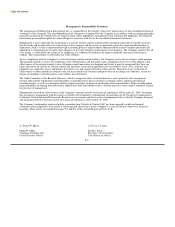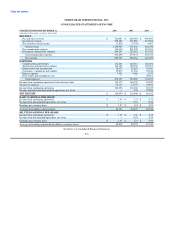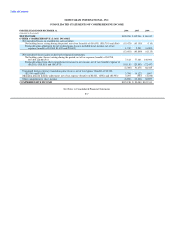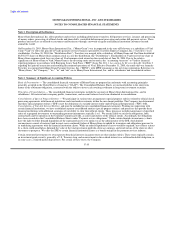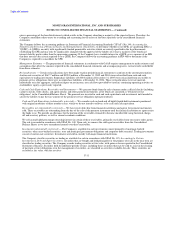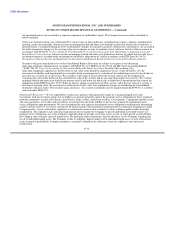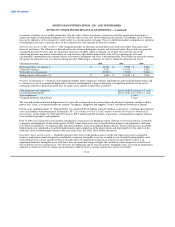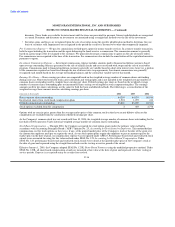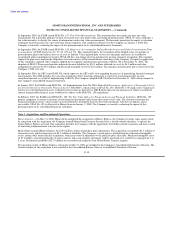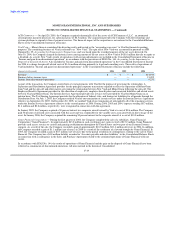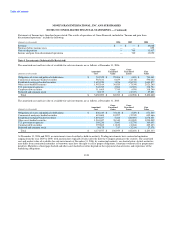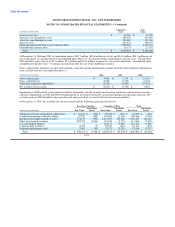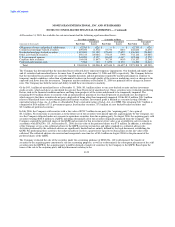MoneyGram 2006 Annual Report Download - page 69
Download and view the complete annual report
Please find page 69 of the 2006 MoneyGram annual report below. You can navigate through the pages in the report by either clicking on the pages listed below, or by using the keyword search tool below to find specific information within the annual report.
Table of Contents
MONEYGRAM INTERNATIONAL, INC. AND SUBSIDIARIES
NOTES TO CONSOLIDATED FINANCIAL STATEMENTS — (Continued)
tax unrealized gain or loss recorded as a separate component of stockholders' equity. The Company has no securities classified as
held-to-maturity.
Other asset-backed securities are collateralized by various types of loans and leases, including home equity, corporate, manufactured
housing, credit card and airline. Interest income on mortgage-backed and other asset-backed securities for which risk of credit loss is
deemed remote is recorded utilizing the level yield method. Changes in estimated cash flows, both positive and negative, are accounted
for with retrospective changes to the carrying value of investments in order to maintain a level yield over the life of the investment in
accordance with SFAS No. 91, Accounting for Nonrefundable Fees and Costs Associated with Originating or Acquiring Loans and
Initial Direct Costs of Leases. Interest income on mortgage-backed and other asset-backed investments for which risk of credit loss is
not deemed remote is recorded under the prospective method as adjustments of yield in accordance with EITF Issue No. 99-20,
Recognition of Interest Income and Impairment on Purchased and Retained Beneficial Interests in Securitized Financial Assets.
Securities with gross unrealized losses at the Consolidated Balance Sheet date are subject to our process for identifying
other-than-temporary impairments in accordance with SFAS No. 115, EITF Issue No. 99-20 and SEC Staff Accounting Bulletin
("SAB") No. 59, Views on Accounting for Noncurrent Marketable Equity Securities. Securities that we deem to be
other-than-temporarily impaired are written down to fair value in the period the impairment occurs. Under SFAS No. 115, the
assessment of whether such impairment has occurred is based on management's evaluation of the underlying reasons for the decline in
fair value on a security by security basis. We consider a wide range of factors about the security and use our best judgment in
evaluating the cause of the decline in the estimated fair value of the security and in assessing the prospects for recovery. We evaluate
mortgage-backed and other asset-backed investments rated A and below for which risk of credit loss is deemed more than remote for
impairment under EITF Issue No. 99-20. When an adverse change in expected cash flows occurs, and if the fair value of a security is
less than its carrying value, the investment is written down to fair value. Any impairment charges are included in the Consolidated
Statement of Income under "Net securities gains and losses." If a security is deemed to not be impaired under EITF 99-20, it is further
analyzed under SFAS 115.
Substantially Restricted — We are regulated by various state agencies which generally require us to maintain liquid assets and
investments with an investment rating of A or higher in an amount generally equal to the payment service obligation for those regulated
payment instruments, namely teller checks, agent checks, money orders, and money transfers. Consequently, a significant amount of cash
and cash equivalents, receivables and investments are restricted to satisfy the liability to pay the face amount of regulated payment
service obligations upon presentment. We are not regulated by state agencies for payment service obligations resulting from outstanding
cashier's checks; however, we restrict a portion of the funds related to these payment instruments due to contractual arrangements and/or
Company policy. Assets restricted for regulatory or contractual reasons are not available to satisfy working capital or other financing
requirements. The regulatory and contractual requirements do not require the Company to specify individual assets held to meet our
payment service obligations; nor is the Company required to deposit specific assets into a trust, escrow or other special account. Rather,
the Company must maintain a pool of liquid assets. No third party places limitations, legal or otherwise, on the Company regarding the
use of its individual liquid assets. The Company is able to withdraw, deposit and/or sell its individual liquid assets at will, with no prior
notice or penalty, provided the Company maintains a total pool of liquid assets sufficient to meet the regulatory and contractual
requirements.
F-12


